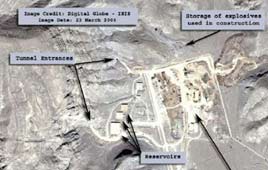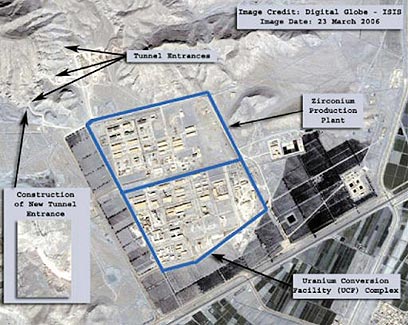
Experts: Iran expanding atomic sites
U.S. think tank says new satellite imagery indicates Iran has reinforced underground uranium enrichment plant against possible military strikes
Iran last week announced it had enriched uranium for use in fuelling power stations for the first time, stoking a diplomatic crisis over Western suspicions of a covert Iranian atomic bomb project. Iran says it seeks only nuclear energy for its economy.
The U.N. Security Council, which could consider sanctions on Iran, has called on Tehran to halt enrichment activity and asked U.N. nuclear watchdog chief Mohamed ElBaradei to report on the Iranian response on April 28. But Iran has accelerated nuclear work and stood its ground during a visit by ElBaradei last week.

Satellite image of uranium conversion site at Isfahan (Photo: Reuters/DigitalGlobe)
The Institute for Science and International Security said in an email sent to news media with attached commercial satellite photos that Iran has built a new tunnel entrance at Isfahan, where uranium is processed into a feed material for enrichment.
There had been just two entry points in February, it said.
"This new entrance is indicative of a new underground facility or further expansion of the existing one," said ISIS, led by ex-U.N. arms inspector and nuclear expert David Albright.
ISIS also featured four satellite images taken between 2002 and January 2006 that it said showed Natanz's two subterranean cascade halls being buried by successive layers of earth, apparent concrete slabs and more earth and other materials.
The roofs of the halls now appear to be eight meters (26 feet) underground, ISIS said.
An investigative report in New Yorker magazine this month said the United States was mulling the option of knocking out subterranean Iranian nuclear sites with tactical atomic bombs.
President George W. Bush dismissed the story as "wild speculation" and said he remained focused on diplomacy to defuse the confrontation with Tehran. But U.S. media accounts of air strike planning by the Bush administration have increased.
Iran taking 'extraordinary precautions'
"Iran is taking extraordinary precautions to try to protect its nuclear assets. But the growing talk of eliminating Iran's nuclear program from the air is pretty glib," Albright told Reuters by telephone from Washington.
"Centrifuges are rather small machines and could be built again quickly, and Iran could store UF6 in a garage somewhere that would be pretty impossible to find," he said.
"It will be very difficult to erase the knowledge they have achieved," said Mark Fitzpatrick, nuclear affairs expert at the International Institute for Strategic Studies in London.
The Isfahan site had stockpiled 110 tons of feedstock UF6 gas, Tehran said last week, 25 more tons than it had reported to ElBaradei's International Atomic Energy Agency in February.
The larger amount could yield a dozen atom bombs once Iran mastered the technology of enrichment in cascades of thousands of centrifuge machines whirling at supersonic speed, a threshold it will probably need 3-10 years to attain, analysts say.
Tehran proclaimed with fanfare that it had managed to enrich the concentration of uranium's fissile U-235 isotope to 3.5 percent, sufficient to run nuclear power plants, in a pilot cascade of 164 centrifuges.
"Even if this is exaggerated, they are close to (enrichment ability) and the world faces a new reality," Fitzpatrick said.
Enrichment must reach at least 80 percent to set off the chain reaction for a nuclear bomb. It would take 164 centrifuges over a decade to purify uranium enough for one bomb.
But Tehran aims to begin installing 3,000 centrifuges later this year, which could produce enough highly enriched uranium for one warhead in a year, nuclear scientists estimate.
Albright said Iran was believed to currently have enough components to set up at least 1,000-2,000 more centrifuges.
Analysts say Iran would need to run thousands of centrifuges for many months to years without breakdown, often caused by excessive vibration or pressure and temperature fluctuations, to prove it could make significant quantities of enriched uranium.










